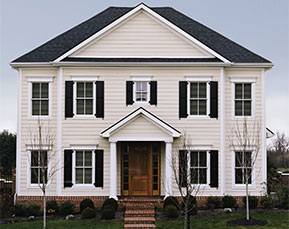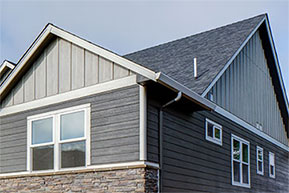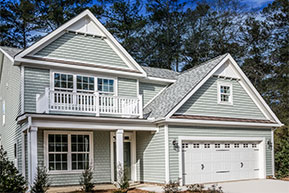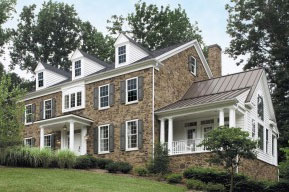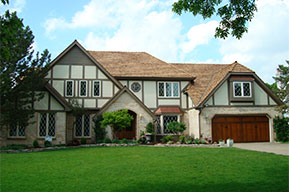Find House Siding That Supports Your Style
by Rachel Lyon, Editorial Director for Direct from the Designers™
When you search through house plans, you’ll see pictures, digital renderings, and even drawings made by hand that show you what the outside of each home looks like. While these give you a good idea of how your new home will look, they are artistic interpretations and you are free to paint the canvas of your own exterior how you see fit. Your build of one of our house plans can look wildly different from what its architect imagined and how other people might finish it!
The type or types of siding you use have a major effect on the final picture that your house shows the world. You can choose to go simple with a uniform exterior or mix and match a palette of different colors, textures, and materials, but first you should familiarize yourself with the options. Here are some of the most commonly used sidings and ideas on how to use them.
Lap Siding
The neat simplicity of lap siding makes it the go-to option for a lot of homes. Contractors typically default to it if they don’t have a client with a specific request because its horizontal lines are timeless and remarkably versatile. Lap siding is perfect for boxy homes like old-style colonials and ranches, but it can really be used on the vast majority of styles with success. More complicated exterior designs often use lap in conjunction with other types of siding to create varied and interesting façades.
Board and Batten Siding
The vertical lines of board and batten siding make a statement. It looks great on rural styles, because it has a history of being used on barns and farm houses, but other types of architecture also make good use of it. Homes with Craftsman characteristics often use board and batten siding as part of an eclectic scheme that shows off a range of materials or simply to accent gables. Due to the lengthening effect of vertical striping, this is a good choice for any part of the home that you want to seem more lofty; even some modern architecture uses it on multi-level construction projects, where lap or stone siding is chosen for the one-story section and board and batten accentuates the two-story portion.
Shingle Siding
Shakes and shingles aren’t the automatic choice that they used to be for the average home, but they are still in demand. Especially popular for architecture that places emphasis on rustic charm, you’ll find them adorning all manners of cottages and cabins. Location often dictates the usage of shingle siding, too, because it has been ingrained in our minds. Houses built in the woods and on the beach are traditionally outfitted with natural materials available in the area to match their surroundings, and hand-split cedar shakes fit the bill. This product changes color as it ages to show off a weathered appearance people love, but you can also buy shingles that are already manufactured with that allure!
Brick Siding
Seen most often in urban environments, brick is right at home on row houses and old American architecture including Mid-Atlantic and Georgian colonial as well as Federal styles. It can make up the entire exterior of one of these homes and look perfectly natural. Brick isn’t nearly as popular in suburban areas except those around Washington, D.C., but used in moderation, it can give a home a dose of old-timey charisma while simultaneously depicting an image of strength. You can find brick used to highlight particular elements of stucco structures and entryways on all kinds of homes.
Stone Siding
A stone exterior is about as unique as it can get, because it is inherently irregular. Different shapes, sizes, and colors create an attractive and balanced look that works with just about every style. Large and rounded stones play up the bucolic element and are perfect for old European cottages and rural estates, while highly regular blocks and tightly stacked stones are favored for contemporary architecture. This is the most diverse type of siding by far, and it gives you the chance to customize your home. Purely stone exteriors aren’t common anymore, but stones make great accents.
Stucco Siding
Stucco is a plaster made of cement, sand, lime, water, and any extra pigment that might be desired. It is exceptionally durable and you’ll find it used on architecture from around the world, including from the English Tudor era, the Mediterranean, and the American Southwest. It might look fairly flat from a distance, but closer inspection reveals a distinctive texture that varies based on the specific formula and application method. It can be smooth or rough and you usually see it in a light neutral color, which is why it is fantastic for homes in the Sunbelt. Stucco must always be installed by a knowledgeable professional to prevent cracks and opening the siding to water damage.
The siding or sidings you choose give your home its personality, so study up on the history of its architecture and see how creative you can get! Matching traditional materials will always be in style, but if you really want to make your home stand out, even just an accent of something out of the ordinary can make all the difference.
BROWSE HOME PRODUCT ARTICLES
- Creating a Spa-Like Master Bathroom »
- Designing a Water-Efficient Bathroom »
- Design a Modern Bathroom »
- View All Bathroom Articles »
- Building a New Home »
- Building a Duplex »
- Finding the Right Home Builder »
- View All Building Tips Articles »
- Adding the Right Columns»
- Decorative Touches for Your Interior»
- Shutters for Every Architectural Style »
- View All Columns & Millwork Articles »
- How to Use Specialty Laminates »
- Decorative Touches for Your Home's Interior
- View All Countertops and Surfaces Articles »
- What Goes Into a Great Deck? »
- Decorative Touches for Your Home's Interior »
- View All Decking Articles »
- Choosing Glass for Your Entry »
- Stylish Personas for Your Front Door »
- Using Sidelites and Transoms »
- View All Door Articles »
- Choose Siding for Your Region »
- Get the Most Out of Exterior Paint »
- Mixing Siding to Define Your Exterior »
- View All Exterior Articles »
- Finding the Right Home Builder »
- The Appeal of Small House Plans »
- Choosing the Perfect Floor Plan »
- View All Finding a Home Plan Articles »
- Colorful Flooring for Your Home »
- Designing With Different Widths»
- Chic, Neutral, Gray Flooring »
- View All Flooring Articles »
- Garage Doors That Add Curb Appeal »
- Caring for Your Garage Doors »
- Benefits of Insulated Garage Doors »
- View All Garage Door Articles »
- Reclaimed Products for Your Home »
- Building a Green and Stylish Home »
- Benefits of Building with SIPS »
- View All Green Building Articles »
- Cool Gadgets for Your New Home »
- Creating a Hi-Tech Home »
- Efficient Gifts for New Homeowners »
- View All Home Electronics Articles »
- Improve Your Home's Air Circulation »
- How to Improve the Air Circulation in Your Home »
- View All HVAC Articles »
- Bedrooms Designed for Sleep »
- Selecting a Fireplace for Your Home »
- Crafting a Luxurious Master Suite »
- View All Interior Design Articles »
- Design the Perfect Outdoor Space »
- Dive into a Beautiful Pool »
- Design a Sizzling Outdoor Kitchen »
- View All Outdoor Living Articles »
- Apps to Help You Pick Paint Colors »
- Create the Perfect Mood with Paint »
- How to Read the Color Wheel »
- View All Painting & Decorating Articles»
- Creating a Spa-Like Master Bathroom »
- High-Impact Kitchen Upgrades »
- Creating a Water Efficient Bathroom »
- View All Plumbing Fixtures Articles»
- Cladding That Complements Your Exterior »
- Reasons to Consider Prefinished Siding »
- View All Siding & Cladding Articles»
- All About Solar Powered Skylights »
- Natural Lighting for the Dark Corners of Your Home »
- Design a Better Bedroom with Skylights »
- View All Skylight Articles»
